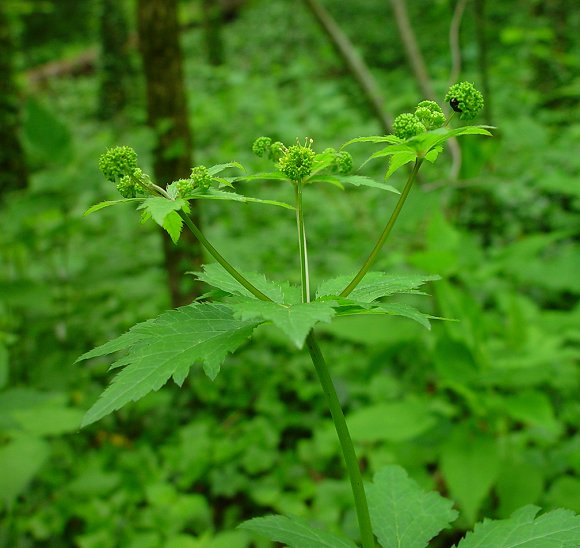Sanicula smallii E.P. Bicknell
Black Snakeroot

Native
CC = 10
CW = 5
MOC = 1
© DETenaglia
Sanicula smallii E.P. BicknellBlack Snakeroot | |
 |
Native CC = 10 CW = 5 MOC = 1 |
© DETenaglia |
|
Family - Apiaceae Habit - Perennial forb with somewhat tuberous-thickened roots. Stems - Loosely ascending to erect, to 60 cm
Leaves - Basal and alternate, with one or more basal leaves usually present at flowering. Basal leaves long-petiolate. Median and upper leaves sessile or short-petiolate, the sheathing bases only slightly inflated. Blades 1.5-12.0 cm long, broadly triangular, deeply palmately lobed and/or compound with mostly 3 or 5 lobes. Lobes elliptic-lanceolate to ovate in outline, pointed at the tip, tapered at the base, sometimes with additional irregular lobes, the margins sharply and doubly toothed, the teeth often with slender spiny tips.
Inflorescence - Terminal and sometimes axillary compound umbels, usually long-stalked, the branch points with pairs of leafy bracts. Involucre with the bracts 6-40 mm long. Rays 0.2-3.0 cm long. Umbellets all with a mixture of staminate and pistillate flowers, the staminate flowers usually 1-7 per umbellet. Flowers - Sepals 1.0-1.5 mm long, fused only at the base, narrowly lanceolate, with the tip tapered to a sharp point. Petals greenish white, usually shorter than the sepals. Stamens with the anthers white. Styles minute triangular scales, shorter than the bristles of the fruit, slightly longer than the sepals. Ovaries densely pubescent with hooked bristles.
Fruits - Schizocarps 4-6 mm long, sessile, densely covered with hooked bristles.
Flowering - May - June. Habitat - Bottomland forests, rich woods. Origin - Native to the U.S. Lookalikes - S. canadensis, S. odorata; more broadly, Cryptotaenia canadensis. Other info. - This species is rare in Missouri, thus far collected from only one far-southern Ozark county in the state. Its main range is to our south and east, with the Missouri record occurring at the far northwestern fringe of the range. The plant strongly resembles S. canadensis and can only be differentiated by careful and detailed examination, so the possibility exists that additional incursions into Missouri are present but not yet detected. Relative to its close relatives, S. smallii has larger, sessile fruits, styles shorter than the fruit bristles but slightly longer than sepals, and tuberous-thickened roots. The fruits typically occur in groups of 3. Photographs taken in Brown Summit, NC., 6-17-2002 and in Linville, NC., 5-11-03 (DETenaglia). |